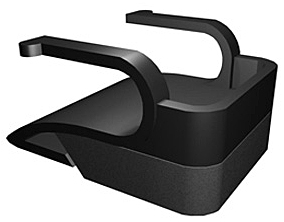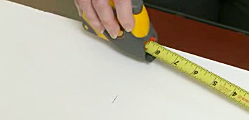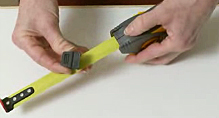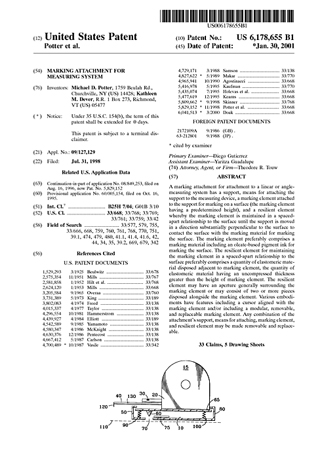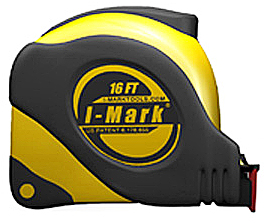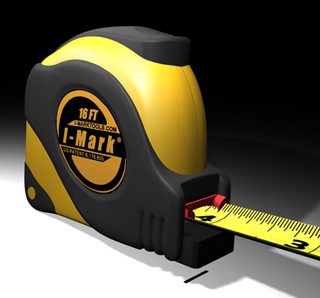
If Kathy Dever’s efforts to create a better tape measure are a fair litmus test, bringing a new invention to market is much more about perspiration than inspiration. But sweat equity has not deterred her from spending nearly 17 years developing the I-Mark Marking Tape Measure. “The thing that has kept me going through it all is that I’ve been using my tape measure in my own work, and I continue to say to myself, ‘Wow, this is so easy.’ If it didn’t work for me, I would have abandoned the whole thing a long time ago,” she says.
Kathy’s invention is really quite simple: It’s a 16-ft. tape measure with a marking cartridge underneath, filled with an ink-based marking medium. You draw out the tape and engage or align the end hook as usual. A pair of red index points on the tape measure’s housing show you your length of measure. When you reach the length you need, pushing down on the tape case leaves a crisp, 1/64-in.-thick line to mark the distance. Her self-marking tape turns two actions – measuring and marking – into one. No pencil is required.
Dever has been focused on simplifying this routine operation for a very long time. Her first career as a physical education teacher and gymnastics coach set the wheels in motion early on. “I spent a great deal of my job watching peoples’ movements and trying to eliminate unnecessary motion where I could. That’s what gymnastics is all about – perfecting how the body moves.”
About three decades ago, Dever changed her career to interior decorating, where measuring and marking window treatments has been a constant part of her work. “For a long time, I’ve thought that measuring and marking is an awkward task – drawing out and hooking the tape, reaching for a pencil, often changing hands between the pencil and tape measure and then finally making the mark. Then, around 1994 I was working with a tile layer on a jobsite who was using the end hook of his tape measure to scratch a measurement into a work surface. A light went on for me.” She wondered if it could be possible to put a marking device right into the end hook.
That glimmer of design inspiration was fortified when, on a New Year’s Eve shortly thereafter, she happened to go to a grocery store that still marked prices with an ink stamper. Kathy recalls watching a clerk mark can after can and wondered why a tape measure couldn’t work the same way. “If they hadn’t been so behind the times and without a bar-coded system, I might not have come up with the idea to use the inking system and method I have now.”
But still, the groundwork wasn’t quite completely laid to take her invention forward. Kathy began to assemble rough prototypes using common materials she had on hand: Sculpey® modeling clay, florists’ foam, cardboard and tape, “but my limitation at that point was that I didn’t know how to patent anything.” Fortunately, Burlington, Vermont – Kathy’s home base – has a local inventors group where she met her first business partner, Mike Potter. “Mike understood the patenting process and agreed to help me write my first couple of patents. He taught be how to strengthen our patents by broadening their scope…there’s quite a process and jargon for patenting something, and Mike helped me avoid many of the pitfalls.”
Even with patents in hand, the bigger challenge to bringing I-Mark to market was finding a tape measure manufacturer willing to accept the license for it. Kathy explains that her intention was never to create the tape measure itself – only the marking system to improve it. Still, despite a machined prototype that provided proof of concept and several more patents to refine the design, there were no tape makers willing to assume the the risk and expense of developing the new product. “We met with rejection after rejection after rejection. At times it’s been really discouraging, and in some ways, the challenges haven’t gotten any easier even now.”
Around 2005, Dever and Potter accepted a third partner from the inventor group – Tom Ference – who is a patent agent with a degree from MIT in material science. With one more patent revision, the three decided it was time to launch the product themselves and forego licensing it with another company. They purchased a bulk of tape measures from a British manufacturer and found a local company that could manufacture the marking cartridge to retrofit to them.
The replaceable cartridge clips to the tape measure body, and it only fits the I-Mark tape. Kathy says the marking medium is non-running and leaves a stable pencil-like mark on raw wood, fabric, cardboard, drywall and metal. It is permanent on unsealed surfaces but able to be erased if the contact surface has a finish applied. Each cartridge, according to Dever, will leave hundreds of impressions before needing to be replaced.
So far, the I-Mark Marking Tape Measure has found favorable response within the interior design industry and, although sales so far have been modest, the tape has only been available since last fall. “Several design magazines such as ‘Window Fashion Vision’ have given us some nice exposure. We’ve created a website as well as a number of videos on YouTube. The internet is providing some good feedback about the product as well.” But for the fledgling I-Mark company, fulfilling orders and sending out invoices is still a hands-on effort. Kathy assembles each tape measure with its marking cartridge before mailing it out.
Kathy is hopeful that the ubiquitous nature of measuring and marking with a conventional tape will make the I-Mark a good crossover product for contractors, trim carpenters, craftspeople and woodworkers. “I think it offers a high-tech result with a ‘no-tech’ approach, so really anybody who needs to measure things can use it.” She also plans to use a self-marking system to expand I-Mark into other measuring and marking tools in the future. Those may include stud finders, range finders, levels and digital measuring devices. She’d like to build a whole tool family that effectively works the same way.
Dever admits that developing I-Mark has become an avocation she truly enjoys, and one she probably couldn’t give up, no matter what the long-term outcome may be. But her word to the wise for would-be inventors among us testifies to the challenge: “You have to be lucky at times, and you have to keep on trying.”
